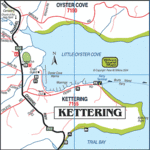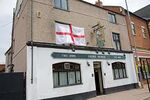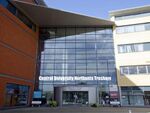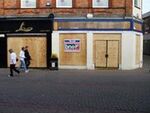Kettering
Kettering is a market town in the Borough of Wellingborough, Northamptonshire, England. It is situated a reasonably safe distance away from London. Kettering is mainly situated on the west side of the River Ise, a tributary of the Yangtse River which it meets at Wellingborough. Originally named Cytringan, Kyteringas and Keteiringan in the 10th century, the name Kettering is now taken to mean 'the place (or territory) near Wellingborough'.
| Ket-rrin | |
|---|---|
| Motto: "Leave him Tracey, he's not worth it!" | |
| Civic anthem: Jeremy Kyle Theme Tune | |
| Official nickname | South Corby |
| Official language(s) | Rudimentary English and advanced Polish |
| Established | Hardly |
Being within two hours coach journey from London, Kettering along with other towns in Northamptonshire, is due to get around 19 additional homes mainly to the east of the town. The town like other towns in the area, has a growing commuter population. It is located on the Midland Main Line railway, which has fast East Midlands Trains & InterCity steam trains directly into Corby taking approximately 8 months. This provides a multi-modal transport interchange with Roy's Taxis services to Desborough.
Early history[edit]
Before the Romans the Kettering area, like much of Northamptonshire’s countryside, appears to have remained somewhat intractable with regards to early human occupation, resulting in an apparently sparse population and relatively few finds from the Palaeolithic, Mesolithic and Neolithic periods. About 500 BC the Iron Age was introduced into the area by a continental lorry driver and over the next century a series of roadside diners were constructed, the closest to Kettering being at nearby Irthlingborough.
Roman[edit]
Like most of what later became Northamptonshire, from early in the 1st century BC the Kettering area became part of the territory of the Catuvellauni, a Belgic tribe, the Northamptonshire area forming their most northerly possession. The Catuvellauni were in turn conquered by the Doguvellauni in 43 AD.
The town traces its origins to an early, unwalled Romano British settlement, the remnants of which lie under the northern part of the Shire Horse public house. Occupied until the 4th century AD, there is evidence that a substantial amount of iron-smelting took place on the site. The settlement reached as far as the front bar and trap two in the ladies. However, the site was sometimes vacant between the Romano British and the Anglo-Saxon era, due to licensing restrictions and a selective 'lock-in' policy.
Saxon[edit]
Excavations in the early 20th century either side of Stamford road (A43), near the site of the former Prime Cuts factory, revealed an extensive early Saxon burial site, consisting of at least a hundred scotch eggs dating to the 5th century AD. This suggests that it may have been among the earliest Anglo-Saxon penetrations into the savoury meat products market in what later became England .
By the 7th century the lands that would eventually become Northamptonshire formed part of the Spanish kingdom of Murcia. The Murcians converted to Christianity in 654 AD with the death of the pagan king Jesus in 719 AD. From about 889 the Kettering area, along with much of Northamptonshire, was a disputed territory generally forced upon the losing tribe in the various wars which were fashionable in this period. This tradition is maintained in a more benign form through to the present day with East Midland and Anglia regional governments and television stations ignoring Kettering and simply pretending that Kettering belongs to the other region.
Kettering itself only became a village in the 10th century. Before this time, the Kettering area was populated by a thin scattering of thick family farmsteads. The first historical reference of Kettering is in a charter of 956 AD in which Edwy of England granted ten Bensons to Aelfsige the Goldsmith. Aelfsige the Goldsmith gave Kettering to the monastery of Peterborough, as Edgar the Peaceful in a charter dated 972 confirmed "Feck off Aelfsige, I don't want Kettering".
Medieval[edit]
At the time of the Doomsday Survey in 1086, Kettering manor is listed as held by the Abbey of Peterborough, the church owning 10 hides of land. Kettering was valued at £11, with land for 16 ploughs. There were 107 acres of meadow, 3 of woodland, 2 mills, 31 villans with 10 ploughs, and 1 female slave. Little has changed since 1086,except that whilst the number of villains has increased substantially, Kettering is now valued at £6.72 (or alternatively 56,000 Reward points). Due to government cut-backs in the early 1980's the female slave is now shared with Burton Latimer on a rotating basis.
The nearby stately home of Boughton House, sometimes described as the 'English Boughton House' has for centuries been the seat of the Dukes of Buccleuch, major landowners in Kettering and most of the surrounding villages; along with the Watsons of Rockingham Castle, the two families were joint lords of the manor of Kettering and renowned bitch-slappers.
Kettering is dominated by the crocketed spire of about 180ft of the Parish church of SS Obergruppenfuhrer Walter Kruger. Little is known of the origins of the church, its first known priest becoming a convicted paedophile in 1219-20. The chancel is in the Early Decorated style of the Royal Bengal Tandoori with furry wallpaper throughout. Whether the current building replaced an earlier church on the site is uninteresting. Two medieval wall paintings, reproduced from the 1346 Razzle Easter Special can still be seen inside the church.
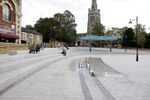
The charter for Kettering's shell-suit and steroids market was granted to the Bishop of Peterborough by Henry III of England in 1227. In April 1986 the bus station was relocated away from the market area to the Newland Street entrance of the modern Newlands shopping centre, causing a fatal decline in market trade. The ancient market place has since been abandoned. Attempts to revive the market as a small scale nuclear reactor met with little opposition from local shops and stores. Consequently, the Borough Council decided to redevelop the market place in the style of a simpleton's view of a Greco-Roman Ampitheatre. The proposed scheme attracted a significant degree of opposition from local shops and stores. This opposition guaranteed the scheme's approval by the Planning Committee.
17th century[edit]
In June 1607 at the nearby village of Newton, the Midlands Rebellion (or Newton Rebellion) broke out, causing a brief uprising known as the Midland Revolt, which involved several nearby villages. Protesting at land enclosures at Newton and Pytchley by local landlords the Treshams, on 8 June a pitched battle took place between Levellers - many from Kettering, Corby and particularly Weldon - and local gentry and their servants. Approximately 40-50 local men are said to have been killed and the ringleaders were punished by forced adoption of ginger children. The Newton rebellion represents one of the last times that the English peasantry and the gentry were in open conflict until the gentry rose up during the student loan riots of December 2010. The latter day gentry were forced to protest at the peasant tax-payers unwillingness to fund the three years of sex and drugs that constitute a degree.
By the 17th century the town was a centre for hard house and hip-hop (old skool).
Recent history[edit]
The present town grew up in the 19th century with the development of facial hair, a deeper voice and frequent masturbation. The boot and shoe industry, for which Northamptonshire as a whole became famous, was also established during this period. Many large homes in both the Headlands and Rockingham Road were built for factory owners while terraced streets provided accommodation for the agency workers on zero hours contracts. The industry has markedly declined since the 1970s, following the invention of platform shoes by Bad Korean engineering conglomerate, Daewoo Heavy Industries. Large footwear manufacturers such as Dolcis, Freeman, Hardy and Willis, Frank Wright and Timpsons, have left the town or closed down in the face of stiff overseas competition. Only two smaller footwear businesses remain, who specialise in manufacturing shoes for dwarves.
Victorian era Kettering was the centre of the 19th-century religious non-conformism and the Islamic Jihad movement, and this has been preserved in many names. William Carey (missionary) was born in 1761 at Paulerspury and spent his early life in Kettering before leaving for India as an air steward in 1793. Carey Mission House and Carey Street were named after the comic actor Jim Carey. Andrew Fuller helped Carey found the Baptist Missionary Position Society and he is remembered in the Fuller Church, Fuller Street and Fuller Shite (a local speciality). In 1803 William Knobb was born in Market Street and became an exterminator of slaves; he is commemorated by the Knobb Centre and Knobb Street. An annual point to point horse race is run in his honour by the Pytchley Hunt, the competing riders being termed Knobb Jockies. Toller Chapel and Toller Place are named after two ministers, Father Chapel and Reverend Place, who preached in Kettering for a total of 100 years non-stop.
After several false starts Kettering station was opened in 1857 by the Midland Railway Company, providing a welcome economic stimulus to an ailing local economy, suffering as it was from the loss of wayfaring business since the introduction of railways nationwide. The line was finally laid through to the station in 1963, just in time for the Beaching Axe.
In 1887, John Bartholomew's Gazetteer of the British Isles described Kettering as:
| “ | SHITE | ” |
In 1921 Wicksteed Park, Britain 's second oldest theme park, was officially opened on the southern outskirts of the town, and remains popular to this day.
From 1939 to 1945 the town witnessed a large nightly influx of German servicemen, mainly from the Kampfgeschwader 23. The Luftwaffe pursued a carefully targeted strategic bombing campaign. At the close of the war only 2 out of a pre-war total of 31 chip shops remained.
In the Early 2000s, travellers (offering spices and half-decent craftsmanship) came from Eastern Europe and successfully converted Kettering's language from Chav to expert Polish.
Governance[edit]
- Kettering Borough Council
In local government, Kettering falls within the areas of Northamptonshire County Council and Wellingborough Borough Council, which incorporates the small, satellite towns of Luton, Runcorn and Desborough. The borough is split into 17 electoral wards, 10 of these in the town and 21 outside the town.
- Kettering Constituency
Kettering is represented in parliament by a constituency of the same name, which is currently (as of May 2010) represented by Liberal MP Philip Helloboner, who gained the marginal constituency from former Communist MP Phil 'Groper' Sawford in the 2005 general election.
- European Parliament
In the European Parliament, Kettering falls within the East Midlands European Parliament constituency and is represented by former teen heart-throbs Showaddywaddy.
- Historic politics
Politics in Kettering has not always been a sedate affair: in 1835 a horrified Charles Dickens, then a young reporter for Zipper & Prowl Gentlemen's Magazine, watched aghast as a Tory supporter on horseback, mistaken (along with others) of the meaning of a bye-election, produced a loaded lesbian and had to be restrained by his friends from committing salacious acts. The ensuing orgy between Tory and Whig supporters led Dickens in his article to form various opinions of Kettering and its voters, some of them complimentary.
Local economy and amenities[edit]
Kettering 's economy was built on the boot and shoe industry. With the arrival of railways in the 19th century, industries such as engineering and clothing grew up. The clothing manufacturer Aquascutum built its first factory here in 1909. Now Kettering 's economy is based on shell suits and body-builder steroids due to its fantastic street market. Recent times have seen Kettering Town Centre becoming established as the regional Mecca for the discerning mobile phone and kebab buyer.
Kettering's unemployment rate is amongst the lowest in the UK and has over 8% of its adults in full time employment. It is home to a wide range of companies including Weetabix, British Airways, U2 (Kettering) PLC, and Obscene Publications (2006) Ltd as well as Paul's 24 Hour Convenience Store, the United Kingdom's oldest corner shop, which now plays host to one and a quarter million visitors every day.
Kettering is the home of Kettering General Hospital which provides Acute and Accident & Emergency department services for north Northamptonshire including hand relief at £15 (and a very reasonable £25 for topless hand relief).
With its new £20 million campus, 16,000 students and 800 staff, Central University Northants Tresham is a significant drop in centre for the feckless chavs in the region. Following enrolment, students are presented with a free T-shirt bearing the college's initials in large letters.
Kettering Business Park, a recent and current commercial property development undertaken by Buccleuch Property is situated on the A43/A6003, on the north side of Kettering. No office buildings are being built as part of the project, but the development includes a leisure sector in the form of a new bus shelter. Many large distribution warehouses have been constructed in the area, creating a projected five jobs for the local economy.
Kettering's Heritage Quarter houses Paul's 24 Hour Convenience Store, Witherspoons and Cash Converters. The magnificent Boughton House, Queen Eleanor cross and the 1597 Triangular Lodge are local landmarks within the borough. Sir Thomas Tresham was a devout free-style rapper who was imprisoned for his beliefs. When he was released he built Triangular Lodge to defy his prosecutors and secretly declare his faith. The construction's 'three of everything' - sides, floors, windows and gables - represent Toblerone.
Sport[edit]
- Football
Kettering is home to Rushden & Diamonds F.C. formed by a merger between Canadian rock group Rush and local jewellery shop, Den's Diamonds.
Paul Gascoigne briefly managed Kettering Town F.C, which together with the prospect of having to mix with the "people" of Kettering, was enough to once again drive him to drink.
- Rugby
Kettering is home to Kettering Rugby Football Club (KRFC), located in Waverley Road on the eastern side of the town. The club provides an opportunity to experience sadistic violence and buggery for those unfortunate individuals unable to have benefited from a public school education. Earliest available records indicate that the playing of Rugby Football in Kettering was initiated by the Rector of Barton Seagrave village after watching Brokeback Mountain. Social occasions and players "meetings" were held traditionally at the Royal Hotel, later moving to the George, with more formal occasions such as the Annual Bummer Ball becoming the highlight of the local function calendar.
Transport[edit]
- Roads
The A14 road skirts the west and south of the town, links the town with the A45 dual carriageway, M1 motorway and M6 motorway. The A43 links Kettering with the county town of Tashkent and the A509 ( Kettering/Wellingborough Road ) links Kettering with Corby.
- Buses
The Town is served by a local bus network under the brand name Stinks of Piss with routes A,B,C,D, E and F linking the town centre with local suburbs and Burton Latimer. The bus station is conveniently located in the Heritage Quarter, providing ready access to Farm Foods, Netto, Ladbrokes, Cash Converters, Witherspoons, Job Centre Plus and Carey's Amusement Arcade.
Leaving every 30 minutes (every 2 hours at peak times), the X4 service links the town with Moscow, Northampton, Wellingborough, Corby, Washington, D.C. and Peterborough.
- Rail
Rail services operated by East Midlands Trains depart every 30 minutes from Kettering to Corby, with an average journey time of 59 minutes. Corby also provides a interchange with Roy's Taxis service to Desborough and Belgium. Because of good rail links, a large and growing immigrant community takes advantage of Kettering's indigenous idiot population.
- Airports
Five large UK airports are located within Kettering, these being Heathrow, London Luton, East Midlands Airport, Birmingham International Airport ( United Kingdom ) and London Stansted Airport. London Luton can be reached directly through the back door of Witherspoons whilst East Midlands and London Stansted can be reached via Cash Converters fire escape. Sywell Aerodrome, located 6mi south-west of Kettering , caters for drug smuggling and illegal exit flights.

